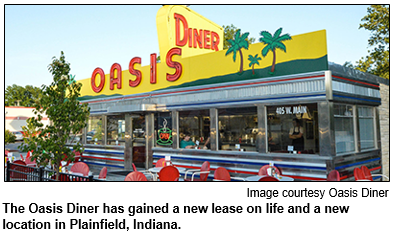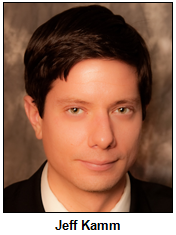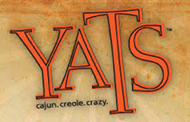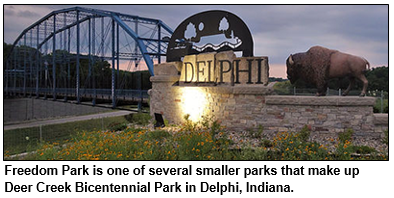Dec. 31, 2016 show
Bygone restaurants in Indy
 Baked Alaska, frog legs or chop suey, anyone? Baked Alaska, frog legs or chop suey, anyone?
Those dishes were popular at several "destination restaurants" in Indianapolis, during bygone eras when "international" cuisine in the Hoosier capital basically meant Italian, Chinese or "French continental" fare.
The latter was on the menu at the elegant King Cole, a grand (some would say "stuffy") restaurant near Monument Circle that, as a new book puts it, "served the jacket-clad set" for nearly 40 years beginning in 1957. The King Cole, which enforced a strict dress code through the 1980s, is among a platter-sized list of bygone dining establishments, ranging from upscale restaurants to diners and drive-ins, that we will explore during our year-end show.
The show won't just look at the heydays of places like the Italian Village (which was hugely popular during the 1950s at a North Meridian Street location), the Key West Shrimp House (a Southside destination during an era when dining on fresh seafood in Indy could be a challenge) and La Tour, a French restaurant nestled on an upper floor of what was known as the Indiana National Bank Tower (now Regions Bank Tower) when it opened in 1970.
 We also will explore the evolution of the public's taste in cuisine, insights about collecting vintage menus from bygone dining establishments, and the challenges of restaurant survival. We also will explore the evolution of the public's taste in cuisine, insights about collecting vintage menus from bygone dining establishments, and the challenges of restaurant survival.
Speaking of survival: Our show will be broadcast on the same day - New Year's Eve - that the Milano Inn will close after 82 years. Ever since the Great Depression, the Milano Inn has served spaghetti, ravioli, chicken cacciatore and other Italian dishes to devoted patrons.
For all of this table talk, Nelson will be joined in studio by:
- Jeff Kamm, an Indy-based history buff who is the author of a new book, Classic Restaurants of Indianapolis (The History Press), that includes profiles of - and vintage advertisements for - many of the bygone restaurants we will explore. They range from long-gone dining establishments like the Huddle Restaurants chain (popular, family-focused eateries that were open 24 hours daily and had an ownership relationship with Haag's Drugs, also bygone) to more recently shuttered restaurants such as Chez Jean, a traditional French restaurant in Camby. According to Jeff's book, the final "guests" in 2009 at Chez Jean were firefighters with the Plainfield Fire Department; they burned the vacant building to the ground in a training exercise.
 And Terry Kirts, the dining critic for Indianapolis Monthly magazine whose culinary articles and restaurant reviews also have appeared in Nuvo, Indianapolis Dine and other publications. Terry is a senior lecturer in creative writing at IUPUI and the author of To the Refrigerator Gods (Seven Kitchens Press, 2010). And Terry Kirts, the dining critic for Indianapolis Monthly magazine whose culinary articles and restaurant reviews also have appeared in Nuvo, Indianapolis Dine and other publications. Terry is a senior lecturer in creative writing at IUPUI and the author of To the Refrigerator Gods (Seven Kitchens Press, 2010).
Terry will set the stage for the emergence of the classic Indianapolis restaurants by sharing history tidbits about Delmonico's, an elegant New York City restaurant during the late 19th century.  It became the model (in terms of decor and menu items, including French continental dishes) for "fine dining" establishments across the country, including Indianapolis. It became the model (in terms of decor and menu items, including French continental dishes) for "fine dining" establishments across the country, including Indianapolis.
The epitome of such establishments on the local scene was the King Cole. "The decor was intentionally stuffy," Jeff writes, noting that it was popular for wedding anniversaries, business meetings and prom dates.
The restaurant's old English interior included oil paintings from the 17th and 18th centuries, leather-upholstered chairs and oak tables. History buffs will be intrigued to learn that the King Cole replaced an upscale restaurant on the site called the Seville; it opened in 1929 in the building at the northeast corner of Meridian and Washington streets.
At the other end of the dining spectrum, bygone diners and drive-ins to be featured during the show will include the beloved TeePee, the legendary drive-in located next to the Indiana State Fairgrounds that became the epicenter for the "cruising" scene in Indy during the 1950s. The TeePee - which was demolished in the 1980s despite howls from preservationists and enthusiasts of pop culture - was so iconic that it's worth another whirl even though Hoosier History Live explored it and other drive-ins across Indiana during a show in November 2011.
 We also will update a show about diners across Indiana that aired in July 2010. At that point, the Plainfield Diner - a landmark on U.S. 40 (the Old National Road) that also became known as the Oasis Diner - was vacant and topped the "10 Most Endangered List" by Indiana Landmarks of threatened historic sites across the state. We also will update a show about diners across Indiana that aired in July 2010. At that point, the Plainfield Diner - a landmark on U.S. 40 (the Old National Road) that also became known as the Oasis Diner - was vacant and topped the "10 Most Endangered List" by Indiana Landmarks of threatened historic sites across the state.
Since then, the "rail car" diner - with its original pink-and-black interior from 1954 - has been moved within Plainfield and has been extensively renovated and is enjoying an Act II. So the roadside diner doesn't quite fit our "bygone" theme, but its story is too enticing to resist, particularly with Jeff Kamm as a guest. Jeff, who grew up in Plainfield and has patronized the diner for most of his life, will share its saga, including how it beat the odds when demolition looked likely.
During the show, Jeff also will offer statistics about percentages of restaurants that don't make it beyond a one-year anniversary.
Some other morsels of the bygone restaurant heritage in Indy:
- Celebrity chef Wolfgang Puck, a native of Austria, got his start in America by working in the kitchen at La Tour in 1973. He has been quoted about his appalled reaction to local dining preferences during the "India-No-Place" era.
- Merrill's Hi-Decker - which, like the TeePee, was a drive-in located near the state fairgrounds - featured a popular disc jockey in a studio perched atop the circular building, as per Jeff's description in Classic Restaurants of Indianapolis. The sites of both drive-ins are now overflow parking lots for the fairgrounds.
-
For nearly 40 years, Jong Mea served Chinese entrees (not, as Jeff puts it in his book, "heavily Americanized chop suey") at a high-visibility site in the 2100 block of North Meridian Street. The family-owned restaurant, which was in a single-story limestone building, closed in 1999.
History Mystery
 The oldest still-operating restaurant in Indianapolis opened in 1894. The oldest still-operating restaurant in Indianapolis opened in 1894.
The restaurant is located inside a distinctive downtown building that recently was named a historic landmark. The restaurant's cuisine is associated with an ethnic heritage group.
Question: What is the restaurant?
The call-in number is (317) 788-3314. Please do not call in to the show until you hear Nelson pose the question on the air, and please do not try to win the prize if you have won any other prize on WICR during the last two months. You must be willing to give your name and address to our engineer and be willing to be placed on the air.
The prize is a gift certificate to Story Inn, a bed and breakfast in Brown County, courtesy of Story Inn.
Roadtrip: Bonneyville Mill County Park
Guest Roadtripper Jane Ammeson recommends Roadtrip to Bonneyville Mill County Park in Elkhart County in north central Indiana. The park has a unique blend of regional history and natural beauty, including 223 acres of gently rolling hills, woodlands, marshes and open meadows.
Seven miles of hiking trails meander through the park, providing nature enthusiasts a chance to view abundant wildlife and beautiful wilflowers. A six-mile designated mountain bike trail provides mountain bikers a thrilling ride through a wooded and rolling terrain. Learn more on Saturday!
Your Hoosier History Live team,
Nelson Price, host and creative director
Molly Head, producer, (317)
927-9101
Richard Sullivan, webmaster and tech director
Pam Fraizer, graphic designer
Garry Chilluffo, media+development director
www.hoosierhistorylive.org
 
 
 
Please tell our sponsors that you appreciate their support: Indiana Historical Society | Lucas Oil | Shirley Brothers Mortuaries & Crematory | Story Inn | Yats Cajun Creole Restaurant
  Acknowledgments to Monomedia, Visit Indy, WICR-FM, Fraizer Designs, Heritage Photo & Research Services, Derrick Lowhorn and many other individuals and organizations. We are an independently produced program and are self-supporting through organizational sponsorships and individual contributions. We do not receive any government funding. Visit our website to learn how you can support us financially. Also, see our Twitter feed and our Facebook page for regular updates. Acknowledgments to Monomedia, Visit Indy, WICR-FM, Fraizer Designs, Heritage Photo & Research Services, Derrick Lowhorn and many other individuals and organizations. We are an independently produced program and are self-supporting through organizational sponsorships and individual contributions. We do not receive any government funding. Visit our website to learn how you can support us financially. Also, see our Twitter feed and our Facebook page for regular updates.

Your donation helps keep Hoosier History Live on the air, on the web and in your inbox!
|
Help keep Hoosier history alive!
A big holiday thanks for your support
Please consider taking a moment to support our unique-in-the-world content.
Hoosier History Live has produced more than 400 episodes - and counting - of original Indiana history journalism.
We are swimming against the tide, in a media landscape where ethical and objective reporting, without bias, has for the most part fallen by the wayside.
If you'd like to be among those individuals and sponsors who value the fresh perspective that Hoosier History Live offers, please consider clicking the big yellow "Donate" button above, or visit our website's "Support the show" page and make a contribution.
Or, you may make out a check to "Hoosier History Live" and mail it to:
Hoosier History Live
P.O. Box 44393
Indianapolis IN 46244-0393
Your support goes toward our ongoing expenses, including website hosting, email marketing software, audio editing, audio archiving and a long list of other items that a media team of any size must have to keep operations going.
We are a small creative/technical group that keeps our history-journalism reporter, Nelson Price, working - creating an Indiana-history archive that grows each week in heft and value. Nelson gets the interviews, and he gets the facts right.
Thanks again to recent individual contributors Carol Bacon, Michael J. Quinn Sr., Jinsie Bingham, Jennifer Smith, Theresa and David Berghoff, Stacia Gorge, Sally Cook, Margaret Smith, Jo Ellen Meyers Sharp and Daniel Craig.
No, we are not a non-profit organization - perhaps soon; that is an ongoing discussion - so we are not in a position to offer a tax deduction. Rather, we are simply a tiny corps of Indiana creators, private citizens who each week create an original radio show, newsletter and website about our great state's history.
Your support helps us keep Hoosier History alive!
Jan. 7, 2017 show - upcoming
Bicentennial wrap-up
As Hoosier History Live begins its ninth year on the air, we will close out a milestone in the state's heritage: the Indiana Bicentennial of 2016.
One of our most frequent recent guests - Perry Hammock, executive director of the Indiana Bicentennial Commission - will join Nelson to look back at projects that unfolded across Indiana. According to Perry, 1,647 projects were initiated in honor of the 200th anniversary of Indiana achieving statehood. In December 1816, Indiana became the 19th state.
 In addition to Perry Hammock in-studio with Nelson, the show will include phone-in reports from grass-roots organizers of Bicentennial projects - or of the Bicentennial torch relay - representing some of the state's 92 counties. In addition to Perry Hammock in-studio with Nelson, the show will include phone-in reports from grass-roots organizers of Bicentennial projects - or of the Bicentennial torch relay - representing some of the state's 92 counties.
For example, Carroll County resident David McCain will share details about a local property owner's donation of land for creation of a Bicentennial Monument.
The monument, a bronze sculpture, will be built in Deer Creek Bicentennial Park, which was dedicated in the historic town of Delphi on Dec. 11 (Statehood Day). Delphi has reaped widespread acclaim for the town's preservation efforts, including showcasing its Wabash & Erie Canal heritage. Bicentennial Park, which remains under development, extends for about one mile from Delphi to a rural historic district. The park is centered at Freedom Bridge, a pedestrian walkway over the Hoosier Heartland Highway.
During our show, reports about other Bicentennial projects are expected from organizers in Miami County (county seat: Peru) and Lawrence County, which includes Bedford.
Our guest Perry Hammock will devote the next several months to putting together an analysis of the Bicentennial, including a book-length publication. A similar "post mortem" occurred after Indiana celebrated its centennial in 1916. A Hoosier History Live show in June 2013 explored how the state marked that milestone 100 years ago.
During the past year, we have highlighted various aspects of the Bicentennial, often with Perry as a guest. Those shows include a "remote" (on-location) broadcast on Oct. 15 of the Hoosier Homecoming, an outdoor event at the newly created Bicentennial Plaza near the Indiana Statehouse. (You can listen to a podcast of that show by visiting our website at hoosierhistorylive.org) During the Hoosier Homecoming, the Bicentennial torch arrived from its 92-county journey.
Perry Hammock, who grew up on a farm near Lebanon, carried the torch in Boone County. About 2,000 torch carriers across the state included participants ranging from children to Hoosiers who are more than 100 years old.
© 2016 Hoosier History Live. All rights reserved.
|